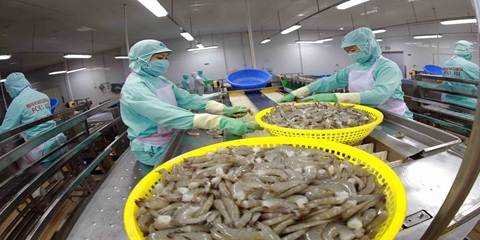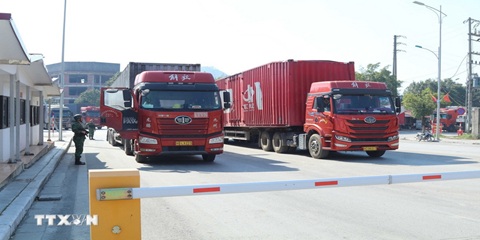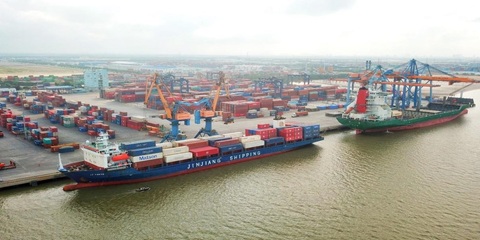Want to be in the loop?
subscribe to
our notification
Business News
BREAKTHROUGHS PINPOINTED FOR VIETNAM’S LOGISTICS SECTOR
Vietnam will have profound opportunities in logistics chain development over the next 2-3 years and beyond if it can also address its shortcomings, according to participants at a summit jointly organised by Vietnam Investment Review and SLP Vietnam last week in Ho Chi Minh City.

Deputy Minister of Planning and Investment Tran Duy Dong noted at the summit, themed “The Path Ahead”, that Vietnam is considered to have plenty of potential and suitable advantages to promote the development of the logistics service industry in the years ahead.
“We are located at the gateway of international trade, and have a strategic position in the global supply chain. With a growing economy, a constantly improving infrastructure system, a population of 100 million people with a rapidly growing middle class, and strong development of e-commerce, we have absolute confidence that Vietnam’s logistics industry will continue to have breakthroughs in the near future,” Dong said.
As the economy at home and abroad recovers from a few tough years, production, business, and import and export activities will regain growth momentum and demand for logistics activities will increase strongly.
“The presence of foreign investors with large-scale projects in Vietnam not only helps to make an important contribution to increasing the capacity of the economy, but it also promotes trade in goods, thereby contributing to the development of the Vietnamese logistics industry as a whole,” Dong added.
According to consulting firm Agility’s assessment, Vietnam has the ability to draw in the most renowned businesses in the world, especially high-tech groups with plenty to offer.
Talking with VIR, Winnie Lam, general secretary of HKBAV and COO of Asivon Young Vietnam, said that Vietnam’s time to shine is now.
“Vietnam stands to gain with the ongoing China+1 strategy and is well positioned in the region to leapfrog others, especially if more attention can be put into ensuring value added services instead of just trying for cheaper services,” said Lam.
She added that China+1 is taking on a new meaning as Vietnam is now not only the +1 for those invested in China, but also for China’s own needs.
“Because Vietnam is up and coming, we should take advantage of adopting the newest technology whenever possible. The logistics sector in Vietnam has been experiencing growth in recent years, and is expected to continue to do so under the current economic situation, being the bright star in the region,” she said.
“Vietnam has plenty of free trade agreements in place, the supply chain is becoming more mature, and Vietnam also benefits from its massive coastline. These all play a significant role in shaping Vietnam’s economy,” Lam added.
According to the 2023 Logistics Performance Index published by the World Bank, Vietnam’s score increased to 3.3 compared to 3.27 points in 2018, ranking it fifth in the ASEAN region - behind Singapore, Malaysia, Thailand, and sitting alongside the Philippines.
According to Deputy Minister Dong, although Vietnam’s logistics sector has a rapid growth rate, in reality, there are still a number of problematic limitations. These include unsynchronised institutions and policies, limited transportation and logistics infrastructure capacity, and a lack of multi-modal transport corridors, all while the need for high-quality transshipment of goods continues to increase.
“Moreover, Vietnam still lacks centralised logistics zones with the most strategic locations, as well as strong connections with ports, airports, national highways, and production facilities. In addition, the operations of logistics enterprises still have many limitations in terms of scale of operation, capital, and especially the lack of talented logistics experts,” he added.
For some of the participants at the summit last week, the most difficult obstacle to overcome is infrastructure.
Infrastructure planning can lack uniformity and regulation from state management agencies is one of the biggest bottlenecks in the industry. Besides that, some said, local infrastructure planning at the locality level can be too vague and not tailored to the condition and strength of each locality.
What makes many businesses worried is that currently, transportation costs on Vietnam’s total logistics costs are at a very high level, up to more than 60 per cent and about twice as high as other countries.
Vietnam currently has about 34,000 businesses in logistics services, but they are mainly small in size and with very limited ability to access international markets. Businesses like these have missed many opportunities to expand their markets and revenues.
Elias Abraham, CEO of Zim Integrated Shipping Company, also assessed that goods to Vietnam only pass through central areas and main ports, so they must be transported over long distances and at high costs.
“Businesses have no other choice. Therefore, various ports in Long An, Phu Yen, and Quang Nam provinces need investment attention,” said Abraham.
Julien Brun, CEO of CEL Vietnam Company, added that in the competition with other countries and regions in foreign direct investment attraction and logistics services, a low price advantage is not enough. Vietnam needs to promote logistics as well as green transformation, which are the factors that the new generation of foreign capital flows towards.
“Vietnam has production costs about 4 per cent lower than India, labour costs are a tenth cheaper, and infrastructure is nearly equivalent, but logistics costs and delivery times are higher and longer,” said Brun.
Source: VIR
Related News

VIETNAM’S SEAFOOD EXPORTS HIT OVER US$10 BILLION IN JAN-NOV
Seafood export revenue in November alone amounted to nearly US$990 million, up 6.6% year-on-year. Key product groups posted solid gains. Shrimp exports rose 11.7% to over US$385 million, supported by strong demand for whiteleg shrimp and lobster. Tra fish shipments increased 9.7% to almost US$197 million, while marine fish, squid, and mollusk exports maintained their recovery.

VIETNAM’S AGRO-FORESTRY-FISHERY EXPORTS HIT NEW RECORD IN JAN-NOV
Vietnam’s agro-forestry-fishery export revenue reached an estimated US$64.01 billion in the first 11 months of 2025, up 12.6% year-on-year and surpassing the full-year record of US$62.4 billion set in 2024. Agricultural exports reached US$34.24 billion, up 15% year-on-year, while livestock products brought in US$567.4 million, a 16.8% increase. Seafood exports rose 13.2% to US$10.38 billion, and forestry products earned US$16.61 billion, up 5.9%.

HANOI REPORTS RECORD-HIGH BUDGET REVENUE IN 2025
Hanoi’s budget revenue is estimated to reach VND641.7 trillion in 2025, the highest level ever recorded and nearly 25% above the revised target, according to a report by the municipal government. Data from the city’s socioeconomic performance review shows that total state budget collections in 2025 are projected to reach 124.9% of the adjusted plan and rise 24.9% from 2024, the Vietnam News Agency reported.

VIETNAM, CHINA TO PILOT TWO-WAY CARGO TRANSPORT AT LANG SON BORDER
Vietnam and China will launch a one-year pilot program on December 10 to allow two-way cargo transport through the Huu Nghi–Youyi Guan international border gates in Lang Son Province, reported the Vietnam News Agency. The Dong Dang-Lang Son Economic Zone Management Board said the trial aims to reduce transport costs and improve customs clearance capacity.

VIETNAM’S IMPORT-EXPORT VALUE NEARS US$840 BILLION IN JAN-NOV
The total value of Vietnam’s imports and exports was nearly US$840 billion between January and November this year, the highest level ever recorded, according to the National Statistics Office. In its latest report on the country’s socio-economic performance, the National Statistics Office highlighted a series of positive economic indicators, with trade emerging as one of the strongest drivers of growth.

OVER 19 MILLION INTERNATIONAL VISITORS COME TO VIETNAM IN JAN-NOV
Vietnam received more than 19.1 million international visitors in the first 11 months of 2025, a 20.9% increase year-on-year and the highest level ever recorded, according to the National Statistics Office. The figure surpasses the full-year record of 18 million arrivals set in 2019, before the Covid-19 pandemic. Nearly two million foreign visitors arrived in November alone, up 14.2% from October and 15.6% from the same period last year.
























